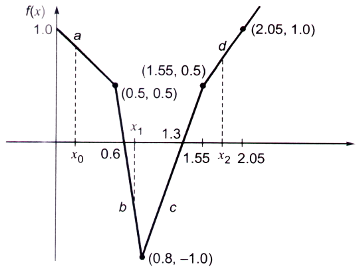42. What is the value of (1525)0.2 to 2 decimal places?
43. Numerical integration using trapezoidal rule gives the best result for a single variable function, which is
44. Solution of the variables x1 and x2 for the following equations is to be obtained by employing the Newton-Raphson iterative method
equation (i) 10x2 sin x1 - 0.8 = 0
equation (ii) 10$${\text{x}}_2^2$$ - 10x2 cos x1 - 0.6 = 0
Assuming the initial values x1 = 0.0 and x2 = 1.0, the Jacobian matrix is
equation (i) 10x2 sin x1 - 0.8 = 0
equation (ii) 10$${\text{x}}_2^2$$ - 10x2 cos x1 - 0.6 = 0
Assuming the initial values x1 = 0.0 and x2 = 1.0, the Jacobian matrix is
45. The root of the function f(x) = x3 + x - 1 obtained after first iteration on application of Newton Raphson scheme using an initial guess of x0 = 1 is
46. The velocity v (in m/s) of a moving mass, starting from rest, given as $$\frac{{{\text{dv}}}}{{{\text{dt}}}} = {\text{v}} + {\text{t}}{\text{.}}$$ Using Euler forward difference method (also known as Cauchy-Euler method) with a step size of 0.1 s, the velocity at 0.2 s evaluate to
47. Let x2 - 117 = 0. The iterative steps for the solution using Newton-Raphson's method is given by
48. A piecewise linear function f(x) is plotted using thick solid lines in the figure below (the plot is drawn to scale).

If we use the Newton-Raphson method to find the roots of f(x) = 0 using x0, x1 and x2 respectively as initial guesses, the roots obtained would be

If we use the Newton-Raphson method to find the roots of f(x) = 0 using x0, x1 and x2 respectively as initial guesses, the roots obtained would be
49. Function f is known at the following points
x
0
0.3
0.6
0.9
1.2
1.5
1.8
2.1
2.4
2.7
3.0
f(x)
0
0.09
0.36
0.81
1.44
2.25
3.24
4.41
5.76
7.29
9.00
The value of $$\int_0^3 {{\text{f}}\left( {\text{x}} \right){\text{dx}}} $$ computed using the continuous at x = 3?
| x | 0 | 0.3 | 0.6 | 0.9 | 1.2 | 1.5 | 1.8 | 2.1 | 2.4 | 2.7 | 3.0 |
| f(x) | 0 | 0.09 | 0.36 | 0.81 | 1.44 | 2.25 | 3.24 | 4.41 | 5.76 | 7.29 | 9.00 |
The value of $$\int_0^3 {{\text{f}}\left( {\text{x}} \right){\text{dx}}} $$ computed using the continuous at x = 3?
